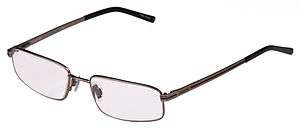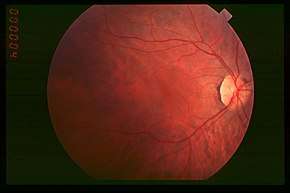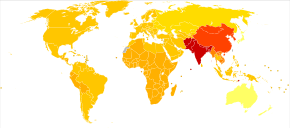Refractive error
Refractive error, also known as refraction error, is a problem with focusing light accurately on the retina due to the shape of the eye.[1] The most common types of refractive error are near-sightedness, far-sightedness, astigmatism, and presbyopia.[1] Near-sightedness results in far away objects being blurry, far-sightedness and presbyopia result in close objects being blurry, and astigmatism causes objects to appear stretched out or blurry.[1] Other symptoms may include double vision, headaches, and eye strain.[1]
| Refractive error | |
|---|---|
 | |
| Glasses are a common treatment for refractive errors | |
| Specialty | Ophthalmology, optometry |
| Symptoms | Blurry vision, double vision, headaches, eye strain[1] |
| Complications | Blindness, amblyopia [2][3] |
| Types | Near-sightedness, far-sightedness, astigmatism, presbyopia[1] |
| Causes | Eyeball length, problems with cornea shape, aging of the lens[1] |
| Diagnostic method | Eye examination[1] |
| Treatment | Eyeglasses, contact lenses, refractive surgery[1] |
| Frequency | ~1.5 billion[4] |
Near-sightedness is due to the length of the eyeball being too long, far-sightedness the eyeball too short, astigmatism the cornea being the wrong shape, and presbyopia aging of the lens of the eye such that it cannot change shape sufficiently.[1] Some refractive errors occur more often among those whose parents are affected.[1] Diagnosis is by eye examination.[1]
Refractive errors are corrected with eyeglasses, contact lenses, or surgery.[1] Eyeglasses are the easiest and safest method of correction.[1] Contact lenses can provide a wider field of vision; however they are associated with a risk of infection.[1] Refractive surgery permanently changes the shape of the cornea.[1]
The number of people globally with refractive errors has been estimated at one to two billion.[4] Rates vary between regions of the world with about 25% of Europeans and 80% of Asians affected.[4] Near-sightedness is the most common disorder.[5] Rates among adults are between 15-49% while rates among children are between 1.2-42%.[6] Far-sightedness more commonly affects young children and the elderly.[7][8] Presbyopia affects most people over the age of 35.[1]
The number of people with refractive errors that have not been corrected was estimated at 660 million (10 per 100 people) in 2013.[9] Of these 9.5 million were blind due to the refractive error.[9] It is one of the most common causes of vision loss along with cataracts, macular degeneration, and vitamin A deficiency.[10]
Classification

An eye that has no refractive error when viewing distant objects is said to have emmetropia or be emmetropic meaning the eye is in a state in which it can focus parallel rays of light (light from distant objects) on the retina, without using any accommodation. A distant object in this case is defined as an object located beyond 6 meters, or 20 feet, from the eye, since the light from those objects arrives as essentially parallel rays when considering the limitations of human perception.[11]
An eye that has refractive error when viewing distant objects is said to have ametropia or be ametropic. This eye cannot focus parallel rays of light (light from distant objects) on the retina, or needs accommodation to do so.
The word "ametropia" can be used interchangeably with "refractive error". Types of ametropia include myopia, hyperopia and astigmatism. They are frequently categorized as spherical errors and cylindrical errors:
- Spherical errors occur when the optical power of the eye is either too large or too small to focus light on the retina. People with refractive error frequently have blurry vision.
- Nearsightedness: When the optics are too powerful for the length of the eyeball one has myopia or nearsightedness. This can arise from a cornea or crystalline lens with too much curvature (refractive myopia) or an eyeball that is too long (axial myopia). Myopia can be corrected with a concave lens, which causes the divergence of light rays before they reach the cornea.
- Farsightedness: When the optics are too weak for the length of the eyeball, one has hyperopia or farsightedness. This can arise from a cornea or crystalline lens with not enough curvature (refractive hyperopia) or an eyeball that is too short (axial hyperopia). This can be corrected with convex lenses, which cause light rays to converge prior to hitting the cornea.
- Presbyopia: When the flexibility of the lens declines, typically due to age. The individual would experience difficulty in near vision, often relieved by reading glasses, bifocal, or progressive lenses.
- Cylindrical errors cause astigmatism, when the optical power of the eye is too powerful or too weak across one meridian, such as if the corneal curvature tends towards a cylindrical shape. The angle between that meridian and the horizontal is known as the axis of the cylinder.
- Astigmatism: A person with astigmatic refractive error sees lines of a particular orientation less clearly than lines at right angles to them. This defect can be corrected by refracting light more in one meridian than the other. Cylindrical lenses serve this purpose.
Other terminology include anisometropia, when the two eyes have unequal refractive power,[12] and aniseikonia which is when the magnification power between the eyes differ.[13]
The optical powers (in units of diopter) of glasses can be used to describe an individual's eyes; or a more subjective quantity visual acuity (expressed as a fraction) may be used, but there is no direct or exact conversion between the two.[14]
Risk factors
Genetics

There is evidence to suggest genetic predilection for refractive error. Individuals that have parents with certain refractive errors are more likely to have similar refractive errors.[1]
The Online Mendelian Inheritance in Man (OMIM) database has listed 261 genetic disorders in which myopia is one of the symptoms.[15] Myopia may be present in heritable connective tissue disorders such as: Knobloch syndrome (OMIM 267750); Marfan syndrome (OMIM 154700); and Stickler syndrome (type 1, OMIM 108300; type 2, OMIM 604841).[16] Myopia has also been reported in X-linked disorders caused by mutations in loci involved in retinal photoreceptor function (NYX, RP2, MYP1) such as: autosomal recessive congenital stationary night blindness (CSNB; OMIM 310500); retinitis pigmentosa 2 (RP2; OMIM 312600); Bornholm eye disease (OMIM 310460).[17] Many genes that have been associated with refractive error are clustered into common biological networks involved in connective tissue growth and extracellular matrix organization.[16] Although a large number of chromosomal localisations have been associated with myopia (MYP1-MYP17), few specific genes have been identified.[15]
Environmental
In studies of the genetic predisposition of refractive error, there is a correlation between environmental factors and the risk of developing myopia.[18] Myopia has been observed in individuals with visually intensive occupations.[17] Reading has also been found to be a predictor of myopia in children. It has been reported that children with myopia spent significantly more time reading than non-myopic children who spent more time playing outdoors.[17] Socioeconomic status and higher levels of education have also been reported to be a risk factor for myopia.
Diagnosis
Blurry vision may result from any number of conditions not necessarily related to refractive errors. The diagnosis of a refractive error is usually confirmed by an eye care professional during an eye examination using a large number of lenses of different optical powers, and often a retinoscope (a procedure entitled retinoscopy) to measure objectively in which the person views a distant spot while the clinician changes the lenses held before the person's eye and watches the pattern of reflection of a small light shone on the eye. Following that "objective refraction" the clinician typically shows the person lenses of progressively higher or weaker powers in a process known as subjective refraction. Cycloplegic agents are frequently used to more accurately determine the amount of refractive error, particularly in children[19]
An automated refractor is an instrument that is sometimes used in place of retinoscopy to objectively estimate a person's refractive error.[20] Shack–Hartmann wavefront sensor and its inverse[21] can also be used to characterize eye aberrations in a higher level of resolution and accuracy.
Vision defects caused by refractive error can be distinguished from other problems using a pinhole occluder, which will improve vision only in the case of refractive error.
Management
How refractive errors are treated or managed depends upon the amount and severity of the condition. Those who possess mild amounts of refractive error may elect to leave the condition uncorrected, particularly if the person is asymptomatic. For those who are symptomatic, glasses, contact lenses, refractive surgery, or a combination of the three are typically used.
Strategies being studied to slow worsening include adjusting working conditions, increasing the time children spend outdoors,[17] and special types of contact lenses.[22] In children special contact lenses appear to slow worsening of nearsightedness.[22][23]
A number of questionnaires exist to determine quality of life impact of refractive errors and their correction.[24][25]
Epidemiology
The number of people globally with refractive errors that have not been corrected was estimated at 660 million (10 per 100 people) in 2013.[9]
The number of people globally with significant refractive errors has been estimated at one to two billion.[4] Rates vary between regions of the world with about 25% of Europeans and 80% of Asians affected.[4] Near-sightedness is one of the most prevalent disorders of the eye.[5] Rates among adults are between 15-49% while rates among children are between 1.2-42%.[6] Far-sightedness more commonly affects young children, whose eyes have yet to grow to their full length, and the elderly, who have lost the ability to compensate with their accommodation system.[7][8] Presbyopia affects most people over the age of 35, and nearly 100% of people by the ages of 55-65.[1] Uncorrected refractive error is responsible for visual impairment and disability for many people worldwide.[9] It is one of the most common causes of vision loss along with cataracts, macular degeneration, and vitamin A deficiency.[10]
Cost
The yearly cost of correcting refractive errors is estimated at 3.9 to 7.2 billion dollars in the United States.[27]
References
- "Facts About Refractive Errors". NEI. October 2010. Archived from the original on 28 July 2016. Retrieved 29 July 2016.
- "Care of the Patient with Amblyopia" (PDF). Retrieved 17 February 2020.
- Dandona, R; Dandona, L (2001). "Refractive error blindness". Bulletin of the World Health Organization. 79 (3): 237–43. PMC 2566380. PMID 11285669.
- Denniston, Alastair; Murray, Philip (2018). Oxford Handbook of Ophthalmology (4 ed.). OUP Oxford. p. 926. ISBN 9780198816751.
- Foster, PJ; Jiang, Y (February 2014). "Epidemiology of myopia". Eye (London, England). 28 (2): 202–8. doi:10.1038/eye.2013.280. PMC 3930282. PMID 24406412.
- Pan, CW; Ramamurthy, D; Saw, SM (January 2012). "Worldwide prevalence and risk factors for myopia". Ophthalmic & Physiological Optics. 32 (1): 3–16. doi:10.1111/j.1475-1313.2011.00884.x. PMID 22150586.
- Castagno, VD; Fassa, AG; Carret, ML; Vilela, MA; Meucci, RD (23 December 2014). "Hyperopia: a meta-analysis of prevalence and a review of associated factors among school-aged children". BMC Ophthalmology. 14: 163. doi:10.1186/1471-2415-14-163. PMC 4391667. PMID 25539893.
- Grosvenor, Theodore (2007). Primary care optometry (5 ed.). St. Louis (Miss.): Butterworth Heinemann, Elsevier. p. 70. ISBN 9780750675758. Archived from the original on 2016-08-15.
- Global Burden of Disease Study 2013, Collaborators (22 August 2015). "Global, regional, and national incidence, prevalence, and years lived with disability for 301 acute and chronic diseases and injuries in 188 countries, 1990-2013: a systematic analysis for the Global Burden of Disease Study 2013". Lancet. 386 (9995): 743–800. doi:10.1016/s0140-6736(15)60692-4. PMC 4561509. PMID 26063472.
- Pan, CW; Dirani, M; Cheng, CY; Wong, TY; Saw, SM (March 2015). "The age-specific prevalence of myopia in Asia: a meta-analysis". Optometry and Vision Science. 92 (3): 258–66. doi:10.1097/opx.0000000000000516. PMID 25611765.
- Bope, Edward T.; Kellerman, Rick D. (2015). Conn's Current Therapy 2016. Elsevier Health Sciences. p. 354. ISBN 9780323355353.
- "Anisometropia - American Association for Pediatric Ophthalmology and Strabismus". aapos.org. Retrieved 10 February 2020.
- "Aniseikonia - EyeWiki". eyewiki.aao.org. Retrieved 10 February 2020.
- "Converting Vision Between Diopters and 20/xx". www.iblindness.org. Retrieved 2020-05-13.
- Morgan, Ian; Kyoko Ohno-Matsui (May 2012). "Myopia". The Lancet. 379 (9827): 1739–1748. doi:10.1016/S0140-6736(12)60272-4. PMID 22559900. S2CID 208793136.
- Wojciechowski, Robert (April 2011). "Nature and Nurture: the complex genetics of myopia and refractive error". Clin Genet. 79 (4): 301–320. doi:10.1111/j.1399-0004.2010.01592.x. PMC 3058260. PMID 21155761.
- Wojcienchowski, Robert (April 2011). "Nature and Nurture: the complex genetics of myopia and refractive error". Clinical Genetics. 79 (4): 301–320. doi:10.1111/j.1399-0004.2010.01592.x. PMC 3058260. PMID 21155761.
- Barnes, Katherine (February 2013). "Genome-wide meta-analyses of multiancestry cohorts identify multiple new susceptibility loci for refractive error and myopia". Nature Genetics. 45 (3): 314–8. doi:10.1038/ng.2554. PMC 3740568. PMID 23396134.
- Roque, B. Refractive errors in children. Archived 2006-10-19 at the Wayback Machine November 2, 2005.
- "Frequently Asked Questions: How do you measure refractive errors?". The New York Eye And Ear Infirmary. Archived from the original on 2006-09-01. Retrieved 2006-09-13.
- "NETRA: Inverse Shack-Hartmann Wavefront Sensor using High Resolution Mobile Phone Display". Vitor F. Pamplona, Ankit Mohan, Manuel M. Oliveira, Ramesh Raskar. Archived from the original on 2011-12-21. Retrieved 2011-12-13.
- Li, X; Friedman, IB; Medow, NB; Zhang, C (1 May 2017). "Update on Orthokeratology in Managing Progressive Myopia in Children: Efficacy, Mechanisms, and Concerns". Journal of Pediatric Ophthalmology and Strabismus. 54 (3): 142–148. doi:10.3928/01913913-20170106-01. PMID 28092397.
- Walline, JJ (January 2016). "Myopia Control: A Review". Eye & Contact Lens. 42 (1): 3–8. doi:10.1097/ICL.0000000000000207. PMID 26513719. S2CID 24069302.
- Kandel H, Khadka J, Goggin M, Pesudovs K (2017). "Patient-reported outcomes for assessment of quality of life in refractive error: a systematic review". Optometry and Vision Science. 94 (12): 1102–1119. doi:10.1097/OPX.0000000000001143. PMID 29095758.
- Kandel H, Khadka J, Lundström M, Goggin M, Pesudovs K (2017). "Questionnaires for measuring refractive surgery outcomes". Journal of Refractive Surgery. 33 (6): 416–424. doi:10.3928/1081597X-20170310-01. PMID 28586503.
- "WHO Disease and injury country estimates". World Health Organization. 2009. Archived from the original on 2009-11-11. Retrieved Nov 11, 2009.
- Kuryan J, Cheema A, Chuck RS (2017). "Laser-assisted subepithelial keratectomy (LASEK) versus laser-assisted in-situ keratomileusis (LASIK) for correcting myopia". Cochrane Database Syst Rev. 2: CD011080. doi:10.1002/14651858.CD011080.pub2. PMC 5408355. PMID 28197998.
External links
| Classification |
|---|
